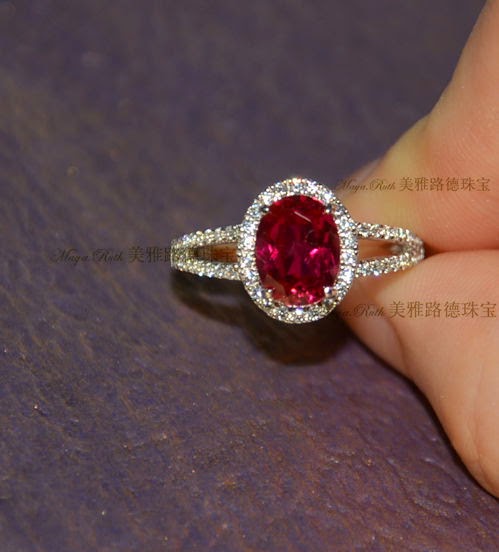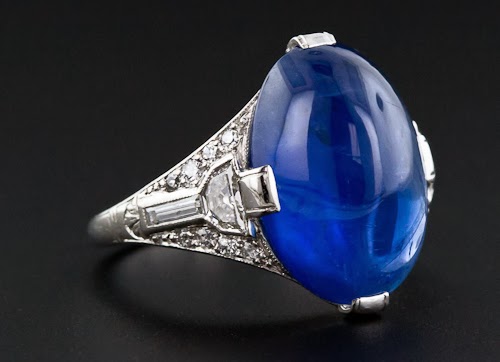Before I start writing this post, I want to warn the readers: I have opinions, just like anyone else. In fact, when it comes to colored stones, nothing is set in stone (of course the pun is TOTALLY intended). If the color of a stone sings to you, don't let it bother you that the color isn't ideal based on "industry standards." Colored stones are something that should make your eyes sparkle when you look at them and should never be purchased just because someone else told you that you should love them.
That being said, I have opinions about rubies.
The word "ruby" makes you think of the most luscious glowing reds. Makes you think of nobility. Makes you think of the colors of love. Let me just tell you . . . sometimes you'll be disappointed. If you really want an amazing, untreated, perfectly colored, inclusion free stone - rubies may not be the one for you; because to find that, you'd have to spend more than an arm and a leg, and you'd probably have to be spend a good chunk of your lifetime looking for it. As I think I've said before: colored stones are a labor of love, so know what you want to put your heart into.
First thing first in your road to semi-education on a rubies is knowing that rubies are in the same family as sapphire. Basically a ruby is a red sapphire. It ranks a 9 on the
Mohs scale. There are lots of pink sapphires out there that are called rubies, but to be a ruby, the stone has to have some red in it. Sounds like a no brainer, but you'd be surprised what people will do to try to sell you a ruby. Because the name alone commands a much higher price tag.
Second thing you should know is that rubies are mined all over the world. Rubies are hosted by very common rocks. Some rubies are marble hosted
and some are basalt hosted
The difference between the rubies found in each type of stone is that basalt has a higher iron content which inhibits the fluorescence in the stone. Fluorescence is responsible for that famous ruby glow
 |
| Photo from Pricescope |
Why this is important to know is because if you're going to buy a ruby and the deal knows its origin (always get a report from a reputable source - I like AGL) then you will begin to know if you're finding your holy grail stone. Some origins that have marble hosted rubies are Tanzania (Winza), Burma/Myranmar, and Mong Hsu (Vietnam).
Even as a newly established colored stone lover, I'm sure you've heard of Burmese rubies. The stuff dreams are made of. Unfortunately it's currently illegal to buy Burmese rubies in the US. There are still some Burmese rubies floating around out there that came to the states before the ban, but you would DEFINITELY want an origin report if you're seriously considering buying it. Just to be mean though, I'll tease you with a few pictures of Burmese rubies.
 |
| Photo from Pricescope |
 |
| Thanks to Fortekitty for the Elizabeth Taylor ruby photos |
 |
| Add caption |
Rubies from regions that have basalt hosted stones are Thailand, and Sri Lanka. They'll be a little darker customarily.
There is a relatively new mine in Tanzania (often referred to as Winza) that has a great supply coming out of it and they are marble hosted. They're also incredibly inclusion free and are almost always untreated (including heat)
Third thing you need to know in your ruby semi-education is about treatments. Many of the treatments for rubies are very similar to those of
blue sapphires:
Heat: Like with blue sapphires, heat is a common practice to brighten colors of rubies and free it from inclusions. It will melt away rutile needles which give that hazy glow effect (sometimes referred to as a sleepy stone) and will also clean up many crystals and minerals in the stone. Almost all rubies are heat treated (except for Winza rubies). Because the heat treatment makes the stone "prettier." Just know right now, you are more than likely never going to find a natural and unheated/untreated ruby that's completely inclusion free. You've gotta learn to love those flaws in our colored stone babies though. It's what makes them unique and who they are.
Fracture/Cavity Filling: Like with blue sapphires, some rubies are dipped in fillers and soaked until they appear to be cleaner and brighter than they would've been naturally. Often times rubies are filled with red glass. As you can imagine this makes a stone that would seem to be safe and gorgeous VERY brittle and dangerous. This is a treatment that lots of chains use on their rubies and how they get those bright colors. If it's too good to be true, that's because it probably isn't true. There's also a technique called quench crackling which takes an otherwise ugly corundum and soaks it in red dye. The effect can be seen with a 10x loupe and looks like the broken up skin of an overtanned 80 year old.

Beryllium Diffusion: Heat treatment of corundum involving lattice diffusion of beryllium has become prevalent in rubies and blue sapphires over the last few years. Initially only orange to orangy pink sapphires were seen with this treatment, it is now known that a full range of corundum colors. Only a qualified lab can detect this treatment, and even for them it's not an easy treatment to see.
There are a LOT of synthetic rubies out there. Their chemical composition is identical to a natural ruby so be very wary of purchasing rubies from unreliable sources. There are a few tricks to determining whether or not a ruby is synthetic. First, a lack of inclusions can be an indicator. But the makers of synthetic rubies are getting smarter and are growing rubies with inclusions just to trick people. Curved color banding and gas bubbles are another indication of synthetic stones. If you see those things under close loupe inspection, be prepared to discover that you may have a synthetic stone on your hands.
As always, buyer beware. You should know by now if you've been reading my blogs that there are some shady sellers out there. Just know what you're getting. If you want a pretty ruby colored stone but don't want to pay ruby prices, that's fantastic. Just don't get taken for a ride. Get what you're paying for.
I hope you all have a blingtastic day!

















































